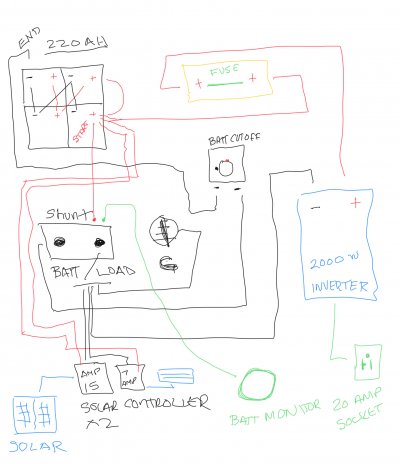Frank B said:
Solarman:
OK, so, if I understand this correctly, to gain capacity, one is better off with one honkin' huge commercial grade high Ah battery (like from a fork lift) rather than multiple GC-2's in parallel strings. If so, then I get that.
As you mention, however, RV applications don't always allow for something like that. That is why I wondered what an alternative would be.
Thanks for the clarification. I appreciate it.
Frank.
"Honkin" battery.. LOL
well not quite, but I get your point.
battery technology is still rather primitive and power density is still low hence the massive
size of these things.. weight is also an issue.. having eight 150 lb batteries in your rig is no fun
to manage.
I think the best way is to limit our demands and camp with a more minimal approach.
however that's not easy for some and therefore large arrays and big batteries come with a price
I see from your sig that you have 1200 Watts of panels.. from that I will assume you boondock a lot
like me or perhaps you are full time ? you need power for at least 4 days before you get the generator out..
so based on that I will approximate your battery size, using common design rules.
I don't know what you have, but just for fun I will estimate your capacity.
here are some figures based on voltage
1200 / 12 V = 100 A
1200 / 24 V = 50 A
1200 / 48 V = 25 A
battery charge should between C/8 to C/12 so the Ah capacity range here is:
12 V = 100A * 8 = 800 Ah or 9600 kWh
12 V = 100A * 12 = 1200 Ah or 14 kWh
for 24 V = 400 to 600 Ah
for 48 V = 200 to 300 Ah
some points here:
100 A is too big by normal design rules and would need a very expensive charge controller or controllers.
preferred methods would push us to use 24 or 48 Volts and cheaper wiring/controller etc..
battery voltage is based on panel watts for example:
up to 600 watts use 12 V or higher
600 to 2000 watts use 24 V or higher
anything larger use 48 V
I am guessing you are on 12 V so you have to have at least 800 Ah of capacity
but I could be wrong.. LOL 800 Ah is not doable in 12 V so you will need parallel
strings.. probably 2S4P so 2 strings of 4 GC2's in parallel ?
eight GC2's at $100 each = $800 plus cabling
and they weigh approx 65lbs each, so 520 lbs total
battery pack is 9.6 kWh in size
If I were to recommend batteries, I would suggest no bigger than a Honking Trojan L16 format
those are 6 Volts and are approx 420 Ah so at 24 Volts you would need four of them in series
they are approx $250 each and weigh about 100lb each, so $1000 and 400lbs
also they have a real good warranty.. note that the preferred design is 150 lbs lighter !
battery pack is 10 kWh in size
if that's too heavy then my next choice would be lithium..
LFP are approx one quarter the weight but at least three times the cost !
if you have deep pockets then you could use large capacity prismatic cells, the initial outlay
is higher, but the long term ownership cost per watt is on par..
I will state this is not for a novice, there are rules that must be followed
in order not to destroy these cells and your RV, having said that you could do 24 V or 48 V with LFP
at any capacity you like..and unlike FLA, LFP can run parallel without issue, in fact the design method
is to choose capacity first then voltage
also with LFP you can discharge to a lower SOC, 20% to 90% is the range
so you get 70% useable capacity instead of 50% that's 20% more than FLA..
at 12V and 800Ah we get 9.6 kWh and you use 50% of that so 4.8 kWh useable
4.8 kWh / 0.7 = approx 6.8 kWh total for LFP
at 12 V is 566 Ah we could use 600 Ah cells
at 24 V is 283 Ah we could use 300 Ah cells
at 48 V is 141 Ah we could use 160 Ah cells
LFP typically run at $1.25 per Ah so you are in the range of $3200 !!
ok, longer post than anticipated, if you need more info, pm me
and i'll be glad to answer any questions..

